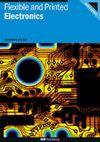Screen printable PANI/carbide-derived carbon supercapacitor electrode ink with chitosan binder
IF 3.2
4区 工程技术
Q3 MATERIALS SCIENCE, MULTIDISCIPLINARY
引用次数: 0
Abstract
Polyaniline (PANI)/carbide-derived carbon (CDC) was synthesized by using使用壳聚糖粘合剂的丝网印刷 PANI/碳化物衍生碳超级电容器电极油墨
聚苯胺(PANI)/碳化物衍生碳(CDC)是在碳化物衍生碳存在的情况下利用原位化学氧化聚合法合成的。在水介质中使用环保型壳聚糖粘合剂制备了导电电极墨水材料。随后,利用刮刀涂层和丝网印刷技术制作了对称超级电容器(SC)。对这些复合材料的导电性、形态、比电容和能量密度进行了评估,以确定它们是否可用作超级电容器电极。含有壳聚糖粘合剂的纯 PANI 因其脆性而无法打印,但 CDC 的存在可以制备出适合电极制备的光滑薄膜。与原始 CDC 电极相比,制备的复合电极具有更高的比电容(高达 419 F g-1)和更高的能量密度(高达 6.7 W h kg-1)。丝网印刷 SC 的电容为 440-470 mF,等效串联电阻约为 27 Ω。
本文章由计算机程序翻译,如有差异,请以英文原文为准。
求助全文
约1分钟内获得全文
求助全文
来源期刊

Flexible and Printed Electronics
MATERIALS SCIENCE, MULTIDISCIPLINARY-
CiteScore
4.80
自引率
9.70%
发文量
101
期刊介绍:
Flexible and Printed Electronics is a multidisciplinary journal publishing cutting edge research articles on electronics that can be either flexible, plastic, stretchable, conformable or printed. Research related to electronic materials, manufacturing techniques, components or systems which meets any one (or more) of the above criteria is suitable for publication in the journal. Subjects included in the journal range from flexible materials and printing techniques, design or modelling of electrical systems and components, advanced fabrication methods and bioelectronics, to the properties of devices and end user applications.
 求助内容:
求助内容: 应助结果提醒方式:
应助结果提醒方式:


